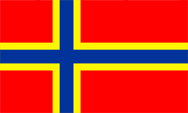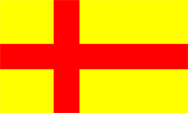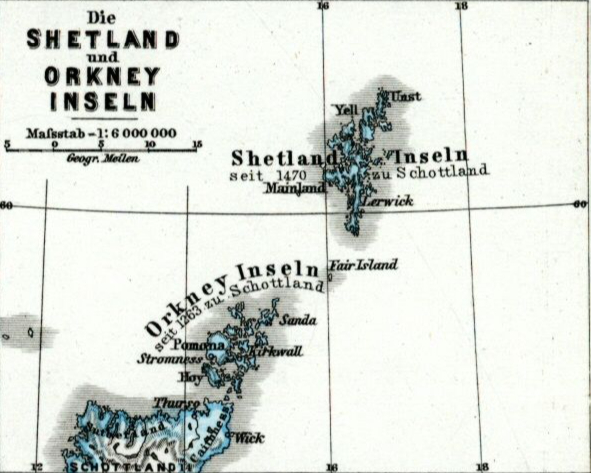Orkney-Inseln |
|
|
|
| Übersicht – Contents: | |
Flagge – Flag: |
|
 |
seit/since März/March 2007, |
historische Flagge – historical Flag: |
|
 |
ca. 1995 – März/March 2007, |
| Orkney, eine Inselgruppe vor Schottlands Nordostküste, ist von Einwohnern nordischer Abstammung bevölkert, daher die Gestaltung der Flagge. Die Farben sind inspiriert von der königlichen schottischen Standarte. Die Orkneys kamen im 15. Jhd. als Heiratsmitgift von Norwegen zu Schottland. Ein nordischer Dialekt, Nornisch genannt, wurde hier bis zum späten 19. Jhd. gesprochen. Als Resultat dieses anderen Verlaufes der Geschichte ist es sehr wahrscheinlich, dass die Orkney-Inseln (und auch die Shetland-Inseln) im Falle der Unabhängigkeit Schottlands, ihren eigenen Weg gehen. Orkney hat die größte Konzentration von archäologischen Fundstätten der Steinzeit in Europa. | Orkney,
an island group off Scotland's north coast, is peopled by folk of Norse
descent, hence the flag (the colours are inspired by Scotland's Royal
Standard). It was granted to the Kingdom of Scotland by Norway as part of a marriage dowry in the 15th century. A Norse dialect, called Norn, was spoken here until the late 19th century. As a result of this differing history, it's likely that if ever Scotland
gains its independence, Orkney and Shetland may
well go their own way. |
| Quelle/Source, Zitat/Citation: Stateless Nations | Quelle/Source: Stateless Nations |
| Die gelbe Flagge mit dem roten Kreuz war immer inoffiziell, und der Gebrauch war lt. Rechtsprechung des Lord Lyon King of Arms in Großbritannien und insbesondere in Schottland sogar verboten, da das Recht zum Führen einer derartigen Flagge nach Farbe und Gestalt – rotes Skandinavierkreuz auf gelbem Grund – gemäß einem Wappenpatent aus dem 19. Jahrhundert allein dem Earl of Londonderry zukommt. Daher wurde im März 2007 eine neue Flagge eingeführt. | The yellow flag with the red cross was always unofficial, and the use was even forbidden in accordance with jurisdiction of the Lord Lyon King of Arms in Great Britain and especially in Scotland, because the right for using of such a flag by colour and form – red Scandinavian cross on yellow ground – is only allowed the Earl of Londonderry in accordance with a coat of arms patent from the 19th century. Because of that was introduced a new flag in March 2007. |
| Wolfgang Schlick www.schottlandportal.de, ca. 2015 www.northernisles.schottlandportal.de, ca. 2015 |
Wolfgang Schlick www.schottlandportal.de, ca. 2015 www.northernisles.schottlandportal.de, ca. 2015 |
| Die im März 2007 eingeführte Flagge zeigt ebenfalls ein skandinavisches Design. Es ist eine Kombination der Farben Norwegens mit denen von Schottland, und soll so auf die historischen Bindungen zu beiden Ländern hinweisen. | The flag was introduced in March 2007 and shows also a Scandinavian design. It is a combination of the colors of Norway and Scotland, and in this way should point out to the historical ties with both countries. |
| Quelle/Source, nach/by Wikipedia (D) | Quelle/Source, nach/by Wikipedia (D) |
| Wappen – Coat of arms: | |
 |
Wappen der Orkney-Inseln – coat of arms of Orkney Islands, Quelle/Source, nach/by: heraldry-wiki.com |
| Das Wappenschild der Orkney-Inseln wurde 1975 geschaffen. Es ist zwischen Rot und Blau gespalten und zeigt im blauen Feld ein Schiff des Sinclair-Clans und im roten Feld den norwegischen Löwen. | The Orkney Islands coat of arms was created in 1975. The shield is parted per pale between red and blue, it shows a ship of the Sinclair clan in the blue field and the Norwegian lion in the red field. |
| Quelle/Source: Wikipedia (EN) | |
Landkarte – Map: |
Lage – Location: Quelle/Source: Freeware, University of Texas Libraries, modyfied by: Volker Preuß |
Landkarte der Orkney- und Shetland-Inseln |
Zahlen und Fakten – Numbers and Facts: |
|
|
|
|
|
|
|
|
|
|
|
|
|
|
|
|
|
|
|
ca. 400 v.Chr. · Einwanderung keltischer Stämme auf die Inseln ca. 700–800 · Wikinger erobern die Orkneyinseln und diese werden eine Grafschaft von Norwegen 995 · beginnende Christianisierung 1263 · Niederlage der Norweger in Schlacht bei Largs, allmählicher Rückgang des norwegischen Einflusses auf die Inseln 1468/1469 · Christian I., König von Dänemark und Norwegen, verpfändet die Orkney- und Shetlandinseln für die Mitgift seiner Tochter Margaret, als Sicherheit für die Heirat mit James III. König von Schottland, die Orkneys werden vom Königreich Schottland annektiert 1472 · Das Pfand wird eingelöst, Schottland annektiert die Inseln 1611 · das dänische Recht wird abgeschafft 2023 · auf den Orkney-Inseln wird offiziell darüber nachgedacht, die Inseln an Norwegen anzuschließen, entweder als ein norwegischer Kronbesitz (vergleichbar dem Status der Inseln Guernsey und Jersey) oder als ein norwegisches Überseegebiet |
|
ca. 400 B.C. · immigration of Celtic tribes toward the islands ca. 700–800 · Vikings capture the Orkney Islands and those become a county of Norway 995 · beginning of conversion to Christianity 1263 · defeat of the Norwegians at Battle of Largs, gradual decline of Norwegian influence on the islands 1468/1469 · Christian I., king of Denmark and Norway, pledges the Orkney and the Shetland Islands for the dowry of his daughter Margaret, as assurance for the marriage with James III. king of Scotland, the Orkneys are annexed by the Kingdom of Scotland 1472 · the pledge gets redeemed, Scotland annexes the islands 1611 · the Danish law gets abolished 1611 · in Orkney, official consideration is being given to annexing the islands to Norway, either as a Norwegian Crown Dependency (comparable to the status of the islands of Guernsey and Jersey) or as a Norwegian overseas territory |
| Quelle/Source: Atlas zur Geschichte, Discovery '97, Wikipedia (DE), Der Spiegel |
| Der Ursprung des Namens der Inseln ist unbekannt, jedoch gibt es einige Theorien: | The origin of the name of the islands is unknown, however there are some theories: |
| A) Der Name der Orkney-Inseln verrät, dass es hier in früheren zeiten viele Wale gegeben haben muss, denn das keltische Wort "orc" heißt "Wal" und das altnorwegische Wort "ey" heißt "Insel". Es sind also die Walinseln. | A) The name of the Orkney Islands reveals that there have been many whales in earlier times, because the Celtic word "orc" means "whale" and the old Norwegian word "ey" means "island". They are the Whale Islands. |
| Quelle/Source: Handbuch der geographischen Namen | |
| B) Der lateinische Name der Inseln, Orcades, geht auf das keltische Wort "ork" zurück, was „junger Eber“ heißt. | B) The islands' Latin name, Orcades, derives from the Celtic word "ork", meaning "young boar". |
| Quelle/Source: Wikipedia (DE) | |
| C) Der Name der Inseln gehe auf eine Bezeichnung zurück, welche die Norweger damals Seehunden gegeben hätten, nämlich: "Orkn". So heißen sie auf Altnordisch "Orkneyjar", was "Seehundsinseln" heißt. | C) The name of the islands goes back to a name that the Norwegians gave to seals at the time, namely: "Orkn". So they are called "Orkneyjar" in Old Norse, which would then mean "Seal Islands". |
| Quelle/Source: Wikipedia (DE) | |



